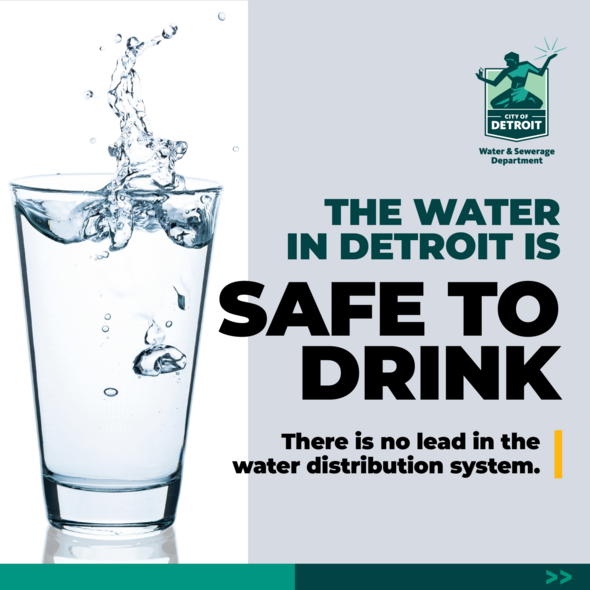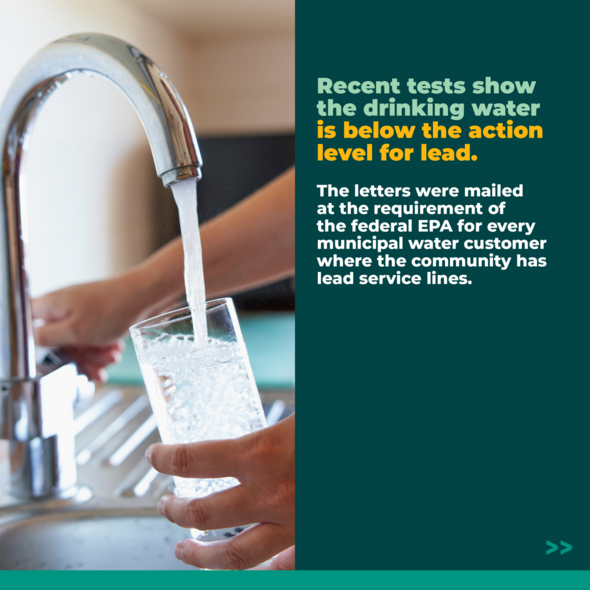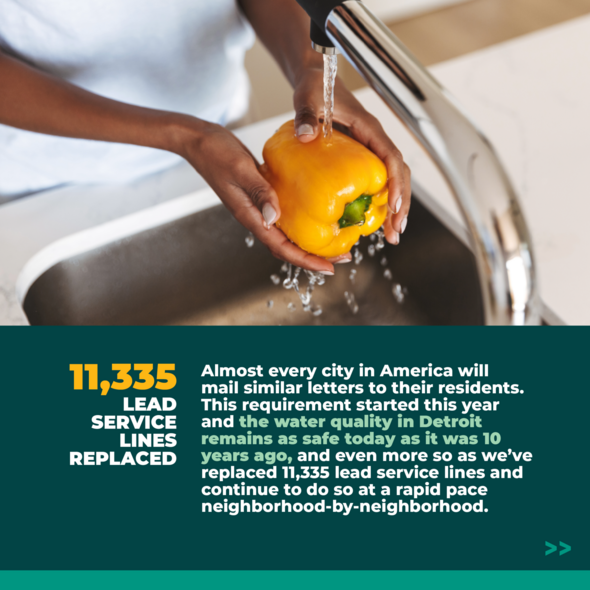Detroit’s drinking water is safe; recent federally required notification caused public concern
- The drinking water meets or exceeds Safe Drinking Water Act standards
- DWSD has mailed now-required annual notices informing residents that a portion or all of their water service line is made from either galvanized material, lead or unknown
- Residents can access DWSD’s Lead Service Line inventory utilizing a public map and verify their service line material
- DWSD continues its accelerated pace of lead service line replacement with a goal to replace all 80,000 lead lines in the next 10 years
The Detroit Water and Sewerage Department (DWSD) has distributed now federally-required annual notices informing the public of water service line material which raised unintended alarm about the drinking water quality. The notifications are about service line inventory and do not change the long-known fact that Detroit’s drinking water is safe, according to DWSD Director Gary Brown.
The new annual notifications are required of all communities with municipal water service and lead service lines, mandated by the U.S Environmental Protection Agency (EPA) as part of the Lead & Copper Rule. The yearly letters will continue until all the lead service lines are replaced. The water service line is the pipe that delivers treated drinking water from the city’s water main to inside the home or business. There is no lead in the water distribution system.
“Our drinking water is safe and DWSD has exceeded all the required tests in the past 20 years and more,” said DWSD Director Brown. “Last week, we mailed notification letters to more than 200,000 residents and businesses about the type of service line you may have based on our updated records. The letters do not indicate any change in the water quality in the system nor at your property – in fact quality continues to improve as we replace lead service lines at a rapid pace.”
Brown added, “The letter stating that a service line material is “unknown” is based on data available to us at this time. We continue to improve our records on a daily basis using mapping technology. We provide instructions on how you can find out whether you have a lead service line or not, and you can provide us that information to update our records.”
Where can residents see the service line inventory?
DWSD launched its first water service line inventory map online for public access using City data and with Ann Arbor-based BlueConduit’s predictive modeling technology. This interactive map displays the verified or assumed status of residents’ pipe material. Residents can access the map by visiting www.detroitmi.gov/lslr.
Residents are encouraged to watch this video to learn how to navigate the map and determine if your water service line material is assumed or verified.
How can residents verify service line material?
Residents can learn how to verify what type of pipe material is their water service line by simply using a magnet and a penny. Use this helpful NPR tool to guide your steps: https://apps.npr.org/find-lead-pipes-in-your-home/en/#. Once verified, take a picture of your pipe and submit results for records here: https://app.smartsheet.com/b/form/a907177537ac44329b3dc8870b0613f8.
DWSD estimates there are 80,000 lead service lines in Detroit. Since 2018, DWSD has replaced 11,335 lead service lines to date and has accelerated the pace of replacement since 2023 with $90 million in federal funding and will soon add $30 million in local bond funds. Utilizing a neighborhood-by-neighborhood approach, areas are being prioritized based on low income Census tracts, density of children or seniors in the homes, and age of housing stock. For a list of current and upcoming neighborhoods, visit www.detroitmi.gov/lslr.
What are the facts?
The water leaving Detroit water treatment plants, operated by the Great Lakes Water Authority (GLWA), does not contain lead, but lead can be released into drinking water from lead service lines and home plumbing as the water moves from the water mains to your tap. Beginning in 1945, Detroit stopped allowing the installation of lead piping for water service lines. Homes before 1945 are most likely to have a lead pipe that connects the home to the water main, known as a lead service line. The lead in lead service lines, household plumbing and fixtures can dissolve or break off into water and end up in tap water. The water provided to DWSD customers contains a corrosion inhibitor to help prevent exposure to lead service lines and other lead components, but lead can still be present in water at the tap.
Brown shares his own experience living with a lead service line, “I’ve lived my entire life in the city of Detroit, and have a lead service line at my own home where there is a three-year-old grandson and an 89-year-old mother-in-law. I use the water at my house, and have full confidence in the quality.”
To learn more, watch this video about lead and Detroit water system.
Below are informative images for the public to share on their social media accounts.



About the Detroit Water and Sewerage Department
The Detroit Water and Sewerage Department (DWSD) delivers clean water and collects sanitary sewage and stormwater from more than 230,000 accounts, representing a residential population of nearly 700,000. DWSD’s water system consists of more than 2,700 miles of water main and 29,000-plus fire hydrants, and the combined sewer collection system has nearly 3,000 miles of sewer piping, more than 90,000 catch basins and 16 green stormwater infrastructure projects within the city of Detroit. Since June 2019, DWSD has committed $100 million per year to begin to address the aging infrastructure, including replacing lead service lines. To learn more about DWSD or to request water services, make payments, apply for affordability programs, or report water or sewer emergencies, call DWSD Customer Service at 313-267-8000, use the Improve Detroit mobile app, or visit detroitmi.gov/dwsd.